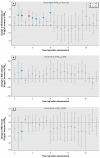Exploration of the rapid effects of personal fine particulate matter exposure on arterial hemodynamics and vascular function during the same day
- PMID: 21681997
- PMCID: PMC3094422
- DOI: 10.1289/ehp.1002107
Exploration of the rapid effects of personal fine particulate matter exposure on arterial hemodynamics and vascular function during the same day
Abstract
Background: Levels of fine particulate matter [≤ 2.5 μm in aerodynamic diameter (PM(2.5))] are associated with alterations in arterial hemodynamics and vascular function. However, the characteristics of the same-day exposure-response relationships remain unclear.
Objectives: We aimed to explore the effects of personal PM(2.5) exposures within the preceding 24 hr on blood pressure (BP), heart rate (HR), brachial artery diameter (BAD), endothelial function [flow-mediated dilatation (FMD)], and nitroglycerin-mediated dilatation (NMD).
Methods: Fifty-one nonsmoking subjects had up to 5 consecutive days of 24-hr personal PM(2.5) monitoring and daily cardiovascular (CV) measurements during summer and/or winter periods. The associations between integrated hour-long total personal PM(2.5) exposure (TPE) levels (continuous nephelometry among compliant subjects with low secondhand tobacco smoke exposures; n = 30) with the CV outcomes were assessed over a 24-hr period by linear mixed models.
Results: We observed the strongest associations (and smallest estimation errors) between HR and TPE recorded 1-10 hr before CV measurements. The associations were not pronounced for the other time lags (11-24 hr). The associations between TPE and FMD or BAD did not show as clear a temporal pattern. However, we found some suggestion of a negative association with FMD and a positive association with BAD related to TPE just before measurement (0-2 hr).
Conclusions: Brief elevations in ambient TPE levels encountered during routine daily activity were associated with small increases in HR and trends toward conduit arterial vasodilatation and endothelial dysfunction within a few hours of exposure. These responses could reflect acute PM(2.5)-induced autonomic imbalance and may factor in the associated rapid increase in CV risk among susceptible individuals.
Figures

Similar articles
-
Impact of personal and ambient-level exposures to nitrogen dioxide and particulate matter on cardiovascular function.Int J Environ Health Res. 2012;22(1):71-91. doi: 10.1080/09603123.2011.588437. Epub 2011 Jun 28. Int J Environ Health Res. 2012. PMID: 21711166 Free PMC article.
-
Hemodynamic, autonomic, and vascular effects of exposure to coarse particulate matter air pollution from a rural location.Environ Health Perspect. 2014 Jun;122(6):624-30. doi: 10.1289/ehp.1306595. Epub 2014 Mar 11. Environ Health Perspect. 2014. PMID: 24618231 Free PMC article. Clinical Trial.
-
Cardiovascular impacts and micro-environmental exposure factors associated with continuous personal PM2.5 monitoring.J Expo Sci Environ Epidemiol. 2014 Jul;24(4):337-45. doi: 10.1038/jes.2013.46. Epub 2013 Aug 28. J Expo Sci Environ Epidemiol. 2014. PMID: 23982121
-
Personal and ambient exposures to air toxics in Camden, New Jersey.Res Rep Health Eff Inst. 2011 Aug;(160):3-127; discussion 129-51. Res Rep Health Eff Inst. 2011. PMID: 22097188
-
Small things make a big difference: particulate matter and exercise.Sports Med. 2012 Dec 1;42(12):1041-58. doi: 10.1007/BF03262311. Sports Med. 2012. PMID: 23098384 Review.
Cited by
-
A Feasibility Study Assessing Acceptability and Supply Issues of Distributing LPG Cookstoves and Gas Cylinders to Pregnant Women Living in Rural Bangladesh for Poriborton: The CHANge Trial.Int J Environ Res Public Health. 2020 Jan 29;17(3):848. doi: 10.3390/ijerph17030848. Int J Environ Res Public Health. 2020. PMID: 32013175 Free PMC article.
-
The impact of fine particulate matter on depression: Evidence from social media in China.PLoS One. 2025 Mar 31;20(3):e0320084. doi: 10.1371/journal.pone.0320084. eCollection 2025. PLoS One. 2025. PMID: 40163502 Free PMC article.
-
Associations between traffic noise, particulate air pollution, hypertension, and isolated systolic hypertension in adults: the KORA study.Environ Health Perspect. 2014 May;122(5):492-8. doi: 10.1289/ehp.1306981. Epub 2014 Mar 6. Environ Health Perspect. 2014. PMID: 24602804 Free PMC article.
-
Long-Term Exposure to Fine Particulate Constituents and Vascular Damage in a Population with Metabolic Abnormality in China.J Atheroscler Thromb. 2023 Nov 1;30(11):1552-1567. doi: 10.5551/jat.64062. Epub 2023 Apr 8. J Atheroscler Thromb. 2023. PMID: 37032101 Free PMC article.
-
Impact of personal and ambient-level exposures to nitrogen dioxide and particulate matter on cardiovascular function.Int J Environ Health Res. 2012;22(1):71-91. doi: 10.1080/09603123.2011.588437. Epub 2011 Jun 28. Int J Environ Health Res. 2012. PMID: 21711166 Free PMC article.
References
-
- Brook RD. Cardiovascular effects of air pollution. Clin Sci. 2008;115:175–187. - PubMed
-
- Brook RD, Bard RL, Burnett RT, Shin HH, Vette A, Croghan C, et al. Differences in blood pressure and vascular responses associated with ambient fine particulate matter exposures measured at the personal versus community level. Occup Environ Med. 2010 doi: 10.1136/oem.2009.053991. [Online 8 October 2010] - DOI - PubMed
-
- Brook RD, Grau M, Kehrer C, Rajagopalan S. Intra-subject variability of radial artery flow mediated dilatation: implications for use in prospective clinical trials. Am J Cardiol. 2005;96:1345–1348. - PubMed
-
- Brook RD, Rajagopalan S. Particulate matter air pollution and blood pressure. J Am Soc Hypertens. 2009;3:332–350. - PubMed
Publication types
MeSH terms
Substances
Grants and funding
LinkOut - more resources
Full Text Sources
Research Materials

